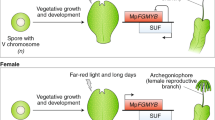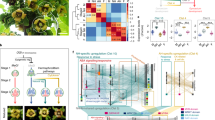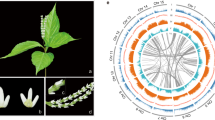Abstract
In flowering plants, the developmental and genetic basis for the establishment of an embryo-nourishing tissue differs from all other lineages of seed plants. Among extant nonflowering seed plants (conifers, cycads, Ginkgo, Gnetales), a maternally derived haploid tissue (female gametophyte) is responsible for the acquisition of nutrients from the maternal diploid plant, and the ultimate provisioning of the embryo. In flowering plants, a second fertilization event, contemporaneous with the fusion of sperm and egg to yield a zygote, initiates a genetically biparental and typically triploid embryo-nourishing tissue called endosperm. For over a century, triploid biparental endosperm has been viewed as the ancestral condition in extant flowering plants1,2,3. Here we report diploid biparental endosperm in Nuphar polysepalum, a basal angiosperm. We show that diploid endosperms are common among early angiosperm lineages and may represent the ancestral condition among flowering plants. If diploid endosperm is plesiomorphic, the triploid endosperms of the vast majority of flowering plants must have evolved from a diploid condition through the developmental modification of the unique fertilization process that initiates endosperm.
This is a preview of subscription content, access via your institution
Access options
Subscribe to this journal
Receive 51 print issues and online access
$199.00 per year
only $3.90 per issue
Buy this article
- Purchase on Springer Link
- Instant access to full article PDF
Prices may be subject to local taxes which are calculated during checkout




Similar content being viewed by others
References
Friedman, W. E. Organismal duplication, inclusive fitness theory, and altruism: Understanding the evolution of endosperm and the angiosperm reproductive syndrome. Proc. Natl Acad. Sci. USA 92, 3913–3917 (1995).
Palser, B. F. The bases of angiosperm phylogeny: embryology. Ann. Missouri Bot. Gard. 62, 621–646 (1975).
Stebbins, G. L. Flowering Plants: Evolution Above the Species Level (Harvard Univ. Press, Cambridge, Massachusetts, 1974).
Mathews, S. & Donoghue, M. J. The root of angiosperm phylogeny inferred from duplicate phytochrome genes. Science 286, 947–950 (1999).
Qui, Y.-L. et al. The earliest angiosperms: evidence from mitochondrial, plastid and nuclear genomes. Nature 402, 404–407 (1999).
Soltis, P. S., Soltis, D. E. & Chase, M. W. Angiosperm phylogeny inferred from multiple genes as a research tool for comparative biology. Nature 402, 402–404 (1999).
Graham, S. W. & Olmstead, R. G. Utility of 17 chloroplast genes for inferring the phylogeny of the basal angiosperms. Am. J. Bot. 87, 1712–1730 (2000).
Barkman, T. J., Chenery, G., McNeal, J. R., Lyons-Weiler, J. & dePamphilis, C. W. Independent and combined analyses of sequences from all three genomic compartments converge on the root of flowering plant phylogeny. Proc. Natl Acad. Sci. USA 97, 13166–13171 (2000).
Endress, P. K. The flowers in extant basal angiosperms and inferences on ancestral flowers. Int. J. Plant Sci. 162, 1111–1140 (2001).
Field, T. S. et al. Structure and function of tracheary elements in Amborella trichopoda. Int. J. Plant Sci. 161, 705–712 (2000).
Friedman, W. E. & Floyd, S. K. The origin of flowering plants and their reproductive biology—a tale of two phylogenies. Evolution 55, 217–231 (2001).
Friedman, W. E. Comparative embryology of basal angiosperms. Curr. Opin. Plant Biol. 4, 14–20 (2001).
Cassman, K. G. Ecological intensification of cereal production systems: Yield potential, soil quality, and precision agriculture. Proc. Natl Acad. Sci. USA 96, 5952–5959 (1999).
Maheshwari, P. An Introduction to the Embryology of Angiosperms (McGraw-Hill, New York, 1950).
Johri, B. M., Ambegaokar, K. B. & Srivastava, P. S. Comparative Embryology of Angiosperms (Springer, Berlin, Germany, 1992).
Winter, A. N. & Shamrov, I. I. Development of the ovule and embryo sac in Nuphar lutea (Nymphaeaceae). Bot. Zhurnal 76, 378–390 (1991).
Battaglia, E. The evolution of the female gametophyte of angiosperms: an interpretative key. (Embryological Questions 14). Ann. Bot. 47, 7–144 (1989).
Orban, I. & Bouharmont, J. Megagametophyte development of Nymphaea nouchali Burm. f. (Nymphaeaceae). Bot. J. Linn. Soc. 126, 339–348 (1998).
van Miegroet, F. & Dujardin, M. Cytologie et histologie de la reproduction chez le Nymphaea heudelottii. Can. J. Bot. 70, 1991–1996 (1992).
Winter, A. N. & Shamrov, I. I. Megasporogenesis and embryo sac development in representatives of the genera Nymphaea and Victoria (Nymphaeaceae). Bot. Zhurnal 76, 1716–1728 (1991).
Batygina, T. B., Shamrov, I. I. & Kolesova, G. E. Embryology of the Nymphaeales and Nelumbonales II. The development of the female embryonic structures. Bot. Zhurnal 67, 1179–1195 (1982).
Galati, B. G. Estudios embriológicos en Cabomba australis (Nymphaeaceae) I. La esporogénesis y las generaciones sexuadas. Boletin Soc. Argentina Bot. 24, 29–47 (1985).
Swamy, B. G. L. Macrogametophytic ontogeny in Schisandra chinensis. J. Indian Bot. Soc. 43, 391–396 (1964).
Yoshida, O. Embryologische studien über Schisandra chinensis Bailey. J. Coll. Arts Sci. Chiba Univ. 3, 459–462 (1962).
Solntseva, M. P. in Comparative Embryology of Flowering Plants (ed. Yakovlev, M. S.) 51–54 (Nauka, Leningrad, Russia, 1981) (in Russian).
Tobe, H., Jaffre, T. & Raven, P. H. Embryology of Amborella (Amborellaceae): descriptions and polarity of character states. J. Plant Res. 113, 271–280 (2000).
Wilson, M. F. & Burley, N. Mate Choice in Plants: Tactics, Mechanisms, and Consequences (Princeton Univ. Press, Princeton, 1983).
Queller, D. C. in Oxford Surveys in Evolutionary Biology (eds Harvey, P. H. & Partridge, L.) 73–109 (Oxford Univ. Press, Oxford, 1989).
Chaw, S. M., Parkinson, C. L., Cheng, Y., Vincent, T. M. & Palmer, J. D. Seed plant phylogeny inferred from all three plant genomes: Monophyly of extant gymnosperms and origin of Gnetales from conifers. Proc. Natl Acad. Sci. USA 97, 4086–4091 (2000).
Bowe, L. M., Coat, G. & dePamphilis, C. W. Phylogeny of seed plants based on all three genomic compartments: Extant gymnosperms are monophyletic and Gnetales' closest relatives are conifers. Proc. Natl Acad. Sci. USA 97, 4092–4097 (2000).
Acknowledgements
We thank P. K. Diggle, L. Hufford and R. H. Robichaux for critical comments on the manuscript and W. Gallup and M. Dozier for assistance with histology. This work was supported by grants from the National Science Foundation to W.E.F.
Author information
Authors and Affiliations
Corresponding author
Ethics declarations
Competing interests
The authors declare no competing financial interests.
Supplementary information
Rights and permissions
About this article
Cite this article
Williams, J., Friedman, W. Identification of diploid endosperm in an early angiosperm lineage. Nature 415, 522–526 (2002). https://doi.org/10.1038/415522a
Received:
Accepted:
Issue Date:
DOI: https://doi.org/10.1038/415522a
This article is cited by
-
Oat species and interspecific amphiploids show predominance of diploid nuclei in the syncytial endosperm
Journal of Applied Genetics (2024)
-
A pentaploid endosperm and a Penaea-type embryo sac are likely synapomorphies of Azorella (Apiaceae, Azorelloideae)
Plant Systematics and Evolution (2022)
-
Insights into the molecular evolution of fertilization mechanism in land plants
Plant Reproduction (2021)
-
Dye- and fluorescence-based assay to characterize symplastic and apoplastic trafficking in soybean (Glycime max L.) endosperm
Botanical Studies (2019)
-
Evidence for post-zygotic self-incompatibility in Handroanthus impetiginosus (Bignoniaceae)
Plant Reproduction (2017)
Comments
By submitting a comment you agree to abide by our Terms and Community Guidelines. If you find something abusive or that does not comply with our terms or guidelines please flag it as inappropriate.



